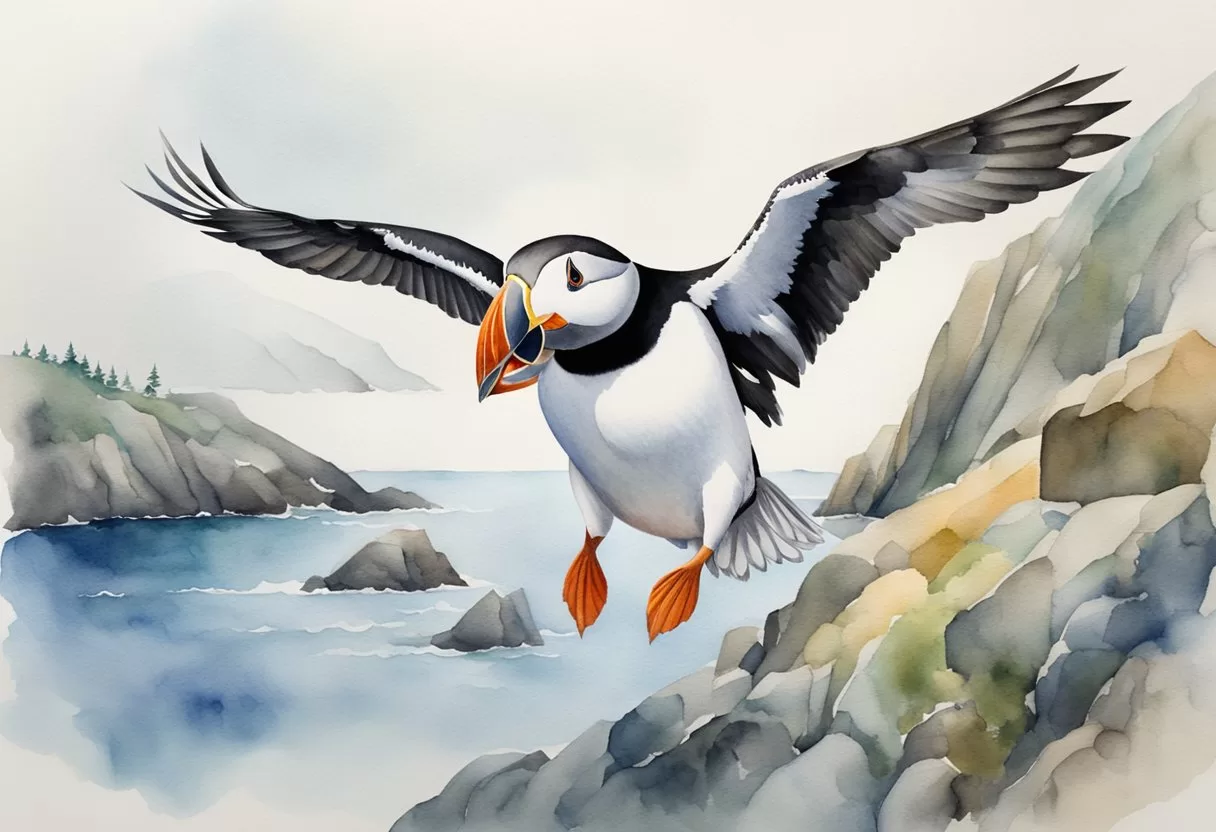Puffin Species and Habitat
Puffins are fascinating seabirds distinguished by their unique adaptations and vibrant characteristics. The Atlantic puffin, also known as Fratercula arctica, is the most well-known species, primarily inhabiting the North Atlantic. Understanding their habitat is crucial for recognizing how they thrive amid changing environmental conditions.
Defining the Atlantic Puffin
The Atlantic puffin is a small seabird belonging to the family Alcidae. They typically measure about 28 to 30 cm (11 to 12 in) in length, with a wingspan of 47 to 63 cm (19 to 25 in). Their distinctive colorful bill is prominent during the breeding season, playing a role in mate attraction.
These birds are well adapted to marine life, diving up to 60 meters to catch small fish. Puffins have exceptional fishing skills, allowing them to carry multiple fish in their beaks at once, showcasing their evolutionary adaptations.
Puffin Habitats in the North Atlantic and North Pacific
Puffins primarily inhabit coastal regions of the North Atlantic and North Pacific. In the North Atlantic, they can be found along the coasts of Canada, Iceland, and Scandinavia. These areas are rich in suitable nesting sites, such as cliff ledges and seabird colonies.
In addition to traditional breeding grounds, climate change poses risks to puffin habitats. Rising temperatures and changing fish populations influence their food supply and nesting success. Maintaining healthy ecosystems is vital for preserving puffin populations and their role in the marine environment.
Puffin Feeding Mechanics

Puffins possess remarkable adaptations that enhance their ability to hunt and transport prey. Understanding the structure of their beak, their diving techniques, and how they manage to carry multiple fish simultaneously reveals their unique feeding mechanics.
Anatomy of the Puffin Beak
The puffin’s beak is a specialized tool for feeding and transport. Its unique structure features a flexible hinge, allowing for the mouth to open wider than many other bird species. This adaptation lets puffins hold multiple fish at once.
The upper and lower mandibles are connected by a soft, stretchy membrane, providing additional control during feeding. This design is particularly advantageous when catching slippery fish like sand eels and herring. Puffins can typically carry up to 60 small fish at a time, showcasing their efficient feeding strategy.
The Dive and Catch Technique
Puffins are exceptional divers, capable of reaching depths of up to 60 meters. They utilize their wings to propel themselves underwater as they search for fish. Puffins primarily hunt small fish, including sand eels, herring, and capelin.
During the dive, puffins rely on their keen eyesight to spot prey. Once they identify a target, they swiftly catch the fish with their sharpened beak. Their diving technique is agile, allowing for effective maneuvering and quick bursts of speed to pursue slippery fish.
Transporting Multiple Fish
The puffin’s ability to carry multiple fish in its beak is an impressive feat. They have a specialized beak structure that allows them to grasp several fish at once while still foraging for more. Puffins can often be seen returning to their nests with multiple catches.
This adaptation is critical for efficient feeding, as it minimizes the number of trips needed to collect food for their young. Puffins can carry a variety of small fish, often balancing up to 50 individuals simultaneously, enhancing their foraging success.
Breeding Season and Puffin Parenting
During the breeding season, puffins exhibit unique parenting behaviors that are essential for raising their young. They build intricate burrows and are dedicated to ensuring their chicks receive adequate nourishment. This period is vital for puffin survival, both in nurturing the next generation and in maintaining healthy populations.
Nesting and Burrow Construction
Puffins typically breed once a year, often between April and August. They seek out coastal cliffs and grassy areas to dig burrows, which can extend over 1.5 meters deep. These burrows serve as protective nests for their eggs and fledgling chicks.
The construction process is critical. Puffins use their beaks and feet to excavate, creating a safe environment away from predators. The burrows are usually lined with grass, feathers, and other organic materials, providing insulation and comfort. With both parents working together, they establish an effective nesting site that promotes the survival of their offspring.
Feeding the Puffin Chicks
Once the eggs hatch, the focus shifts to feeding the puffin chicks. Adult puffins take on the responsibility of providing fish, which is essential for the growth and development of their young. They can carry multiple fish at once, sometimes holding up to 60 small fish in their beaks, which enables efficient feeding.
Both parents participate in this feeding process, with one or both adults regularly returning to the burrow. The chicks rely on a rich diet of small fish like sand eels and herring, which provide crucial nutrients. This parental investment during the early stages significantly increases the likelihood of chick survival in the wild.
Share this content:

Post Comment
You must be logged in to post a comment.